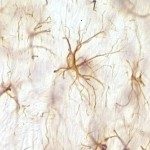Lien vers Pubmed [PMID] – 22730440
FASEB J. 2012 Oct;26(10):3969-79
Antibodies normally do not cross the blood-brain barrier (BBB) and cannot bind an intracellular cerebral antigen. We demonstrate here for the first time that a new class of antibodies can cross the BBB without treatment. Camelids produce native homodimeric heavy-chain antibodies, the paratope being composed of a single-variable domain called VHH. Here, we used recombinant VHH directed against human glial fibrillary acidic protein (GFAP), a specific marker of astrocytes. Only basic VHHs (e.g., pI=9.4) were able to cross the BBB in vitro (7.8 vs. 0% for VHH with pI=7.7). By intracarotid and intravenous injections into live mice, we showed that these basic VHHs are able to cross the BBB in vivo, diffuse into the brain tissue, penetrate into astrocytes, and specifically label GFAP. To analyze their ability to be used as a specific transporter, we then expressed a recombinant fusion protein VHH-green fluorescent protein (GFP). These “fluobodies” specifically labeled GFAP on murine brain sections, and a basic variant (pI=9.3) of the fusion protein VHH-GFP was able to cross the BBB and to label astrocytes in vivo. The potential of VHHs as diagnostic or therapeutic agents in the central nervous system now deserves attention.





